Study Guide
1/104
There's no tags or description
Looks like no tags are added yet.
Name | Mastery | Learn | Test | Matching | Spaced |
|---|
No study sessions yet.
105 Terms
The periphery of the eye is excellent at detecting a small flash of light in the dark, but less able to distinguish changes in the strength of an existing light. If we think about this in terms of thresholds, what can we conclude?
The jnd is a high value (just noticeable difference, it takes a large change for it to be noticeable), the absolute threshold is a low value (it takes very little stimulus to notice).
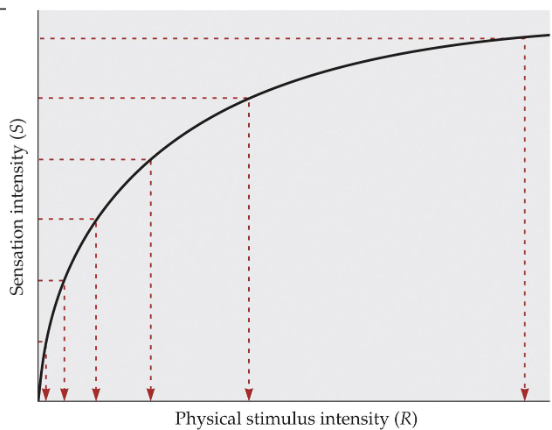
What does the graph illustrate?
Fechner’s Law
The magnitude of subjective sensation increases proportionally to the logarithm of the existing stimulus intensity
dS = k log S
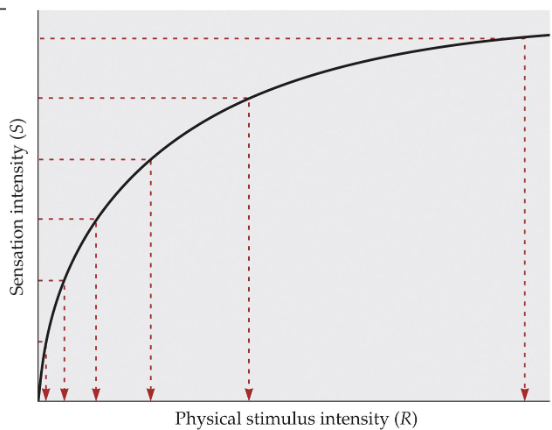
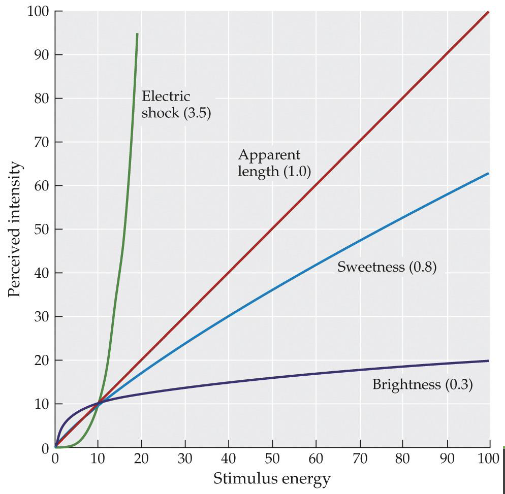
What does the graph illustrate?
Steven’s Law
S = k R. That is, psychological intensity ("Sensation") increases as the nth power of stimulus intensity; again, "k" is simply a scaling constant.
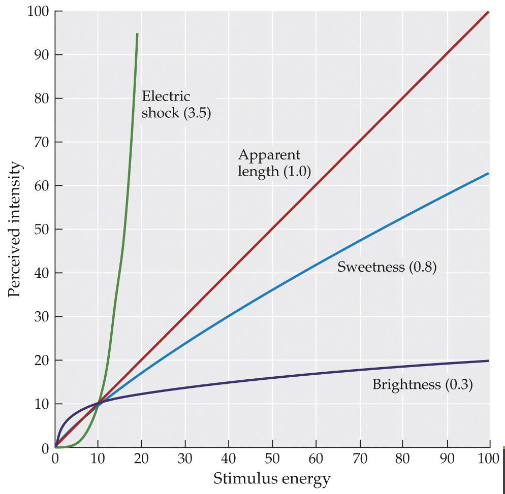
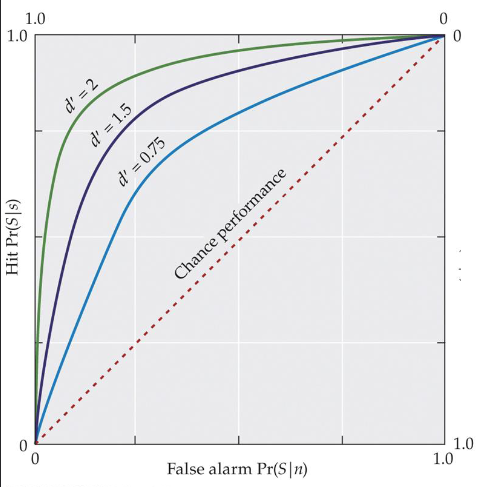
What does the graph illustrate?
Receiver Operating Characteristic (ROC) Curves
Plots Hits vs. False Alarms (both Yes responses)
With greater sensitivity, curve moves closer to top left corner
Criterion is represented by point on the curve
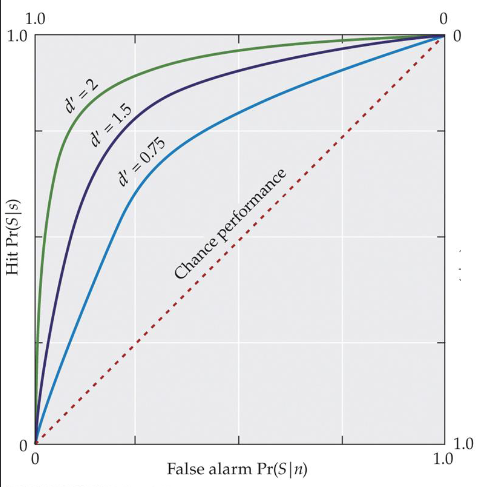
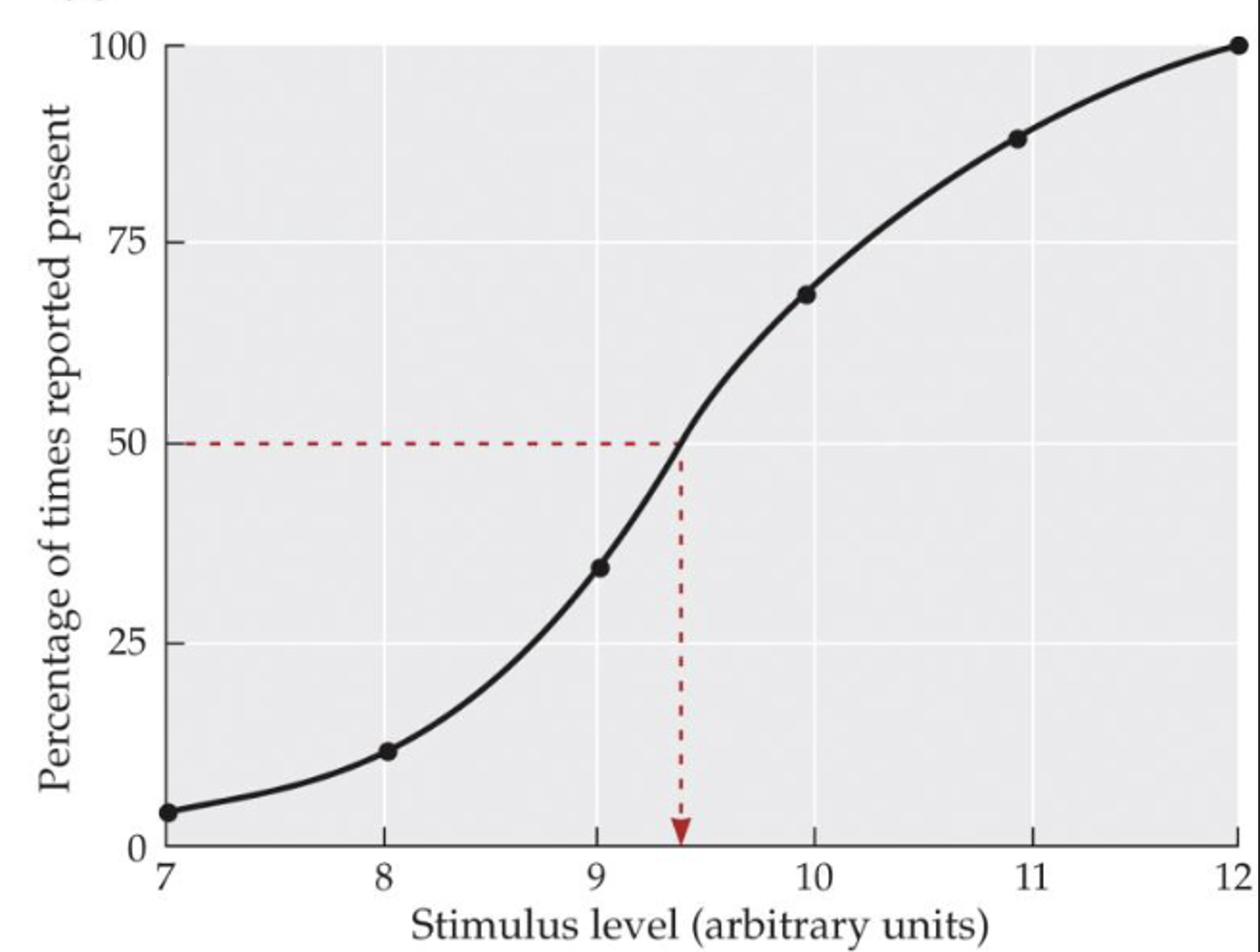
What does the graph illustrate?
Threshold Detection
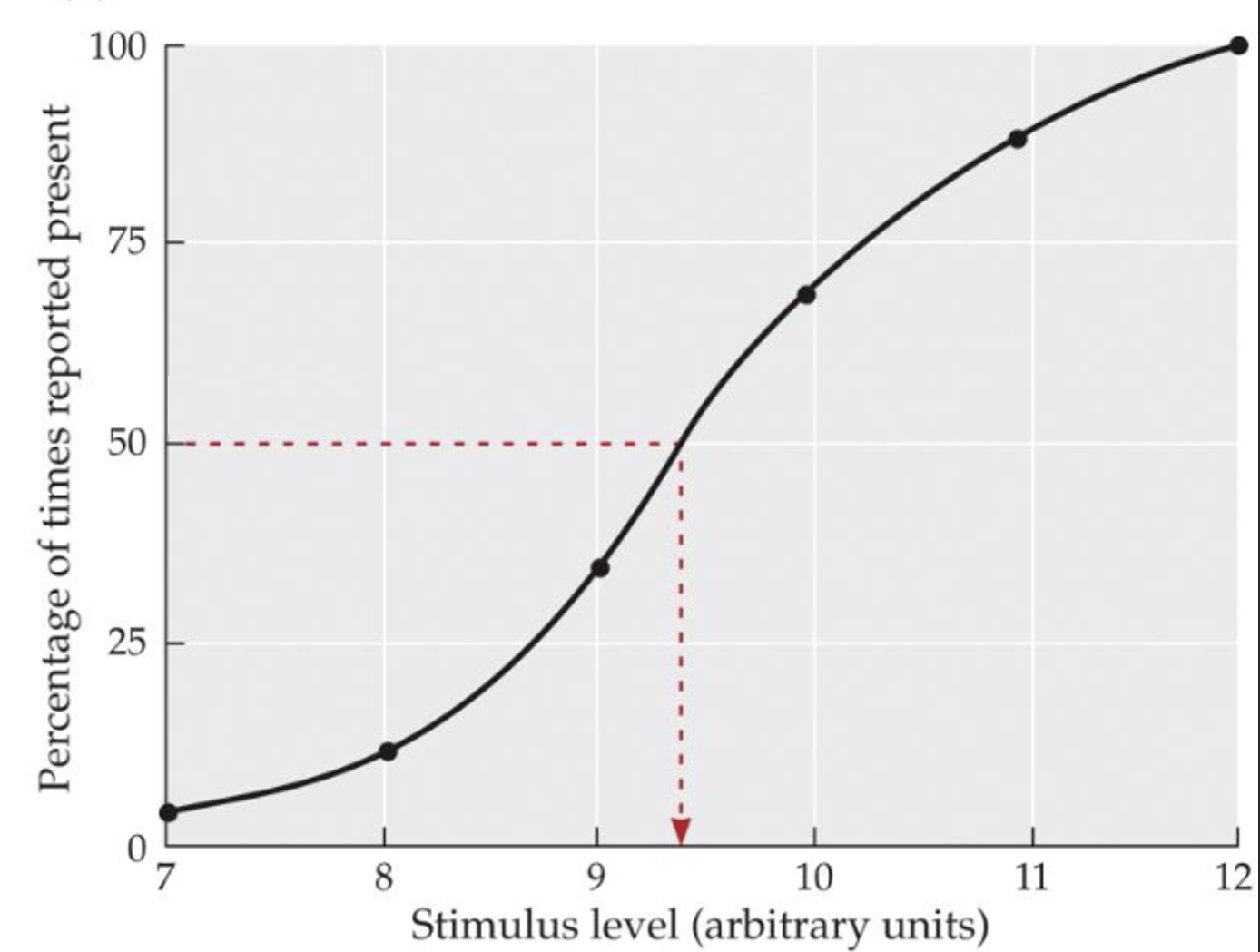
_______ is the principle that describes the relationship between a stimulus and its resulting sensation, which says the magnitude of subjective sensation is proportional to the stimulus magnitude, raised to an exponent, which may differ between varying senses.
Steven’s Power Law
Action potentials
The electrical chemical part of neuronal communication
Neurotransmitters trigger an electrical shift in the post-synaptic neuron, leading to the neuron “firing” an action potential
Neurons fire in an all-or-none fashion for each action potential, or “spike”
The number of spikes per second indicates how excited the neuron is
Each action potential starts near the cell body of a neuron and propagates down the axon towards the axon terminal
Electrochemical process involves Na+ & K+ ions moving in/out of the neuron
Entire populations of neurons work in concert to process information
Action potentials are all or nothing. Action potentials occur when the cell is depolarized from -70mV to -55mV from the opening of the Na+ channels. The cell is then hyperpolarized through the closing of the Na+ channels and opening of the K+ channel. There is a restorative period as the cell overshoots and becomes more negative than -70mV before returning to that value.
Steps of action potientials
Cells polarized in resting state
When AP threshold reached, depolarization occurs down the axon
Then triggers the release of neurotransmitters
But given we have billions of neurons, any given neuron is receiving from and transmitting to many others in an very complex system

Absolute threshold is the minimum amount of stimulation necessary for a person to detect a stimulus _______% of the time.
50%
Fechner’s vs Stevens’s Laws
Logarithmic (Fechner) vs. Power (Stevens) Scale
Both make broad assumptions about the “fit” of data to their metrics and about the scales they work on
Both relationships between stimulus and sensation
Both involve JND
Both are only approximations of data and turn out to not really be “laws”
Main takeaways:
People’s internal perception can be modeled
Sensation is proportional to other parameter
The method of _______ requires the random presentation of many stimuli, one at a time, ranging from rarely to almost always perceivable.
Constant Stimuli
What differentiates the method of Limits from the method of Adjustments?
Main difference between Limits and Adjustments is who controls the change
Limits: the researchers adjust the stimulus
Adjustments: the participants adjust the stimulus
When setting up a new monitor or video game, there is often a step in which you change the brightness of the screen until a logo is just barely visible. This is an example of
An absolute threshold found through the method of adjustment.
_______ is a psychophysical method in which the participant assigns values according to perceived magnitudes of the stimuli
Magnitude Estimation
According to Signal Detection Theory, which of the following would result in an INCREASE in Hits?
Lower Criteria
Increased stimulus sensitivity
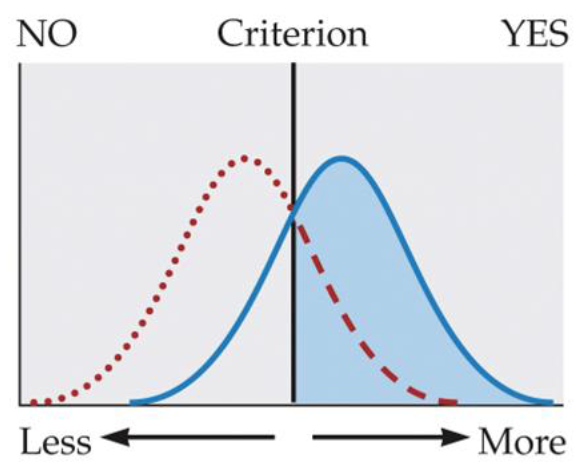
In the graph below, what type of response does the indicated area represent?
Hit
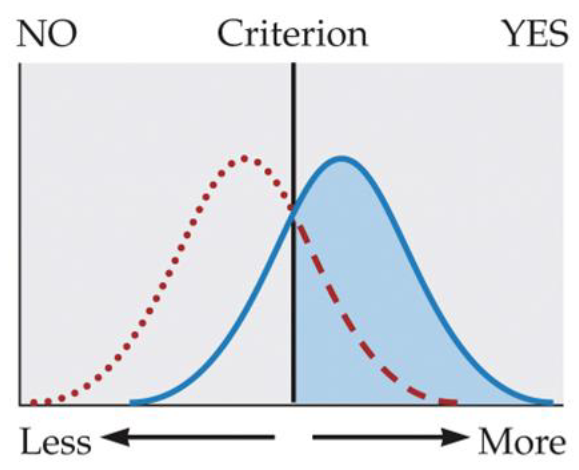
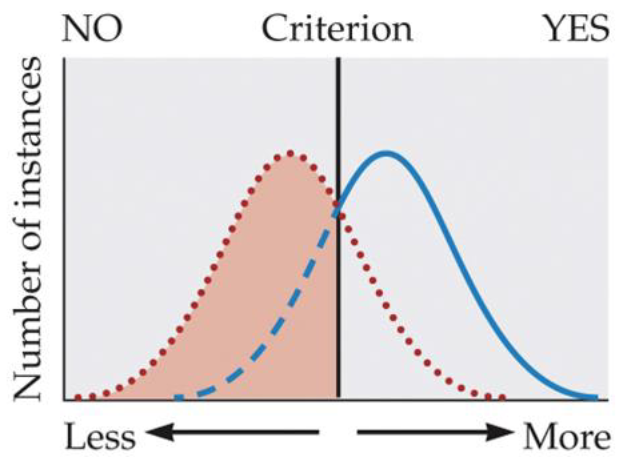
In the graph below, what type of response does the indicated area represent?
Correct rejection
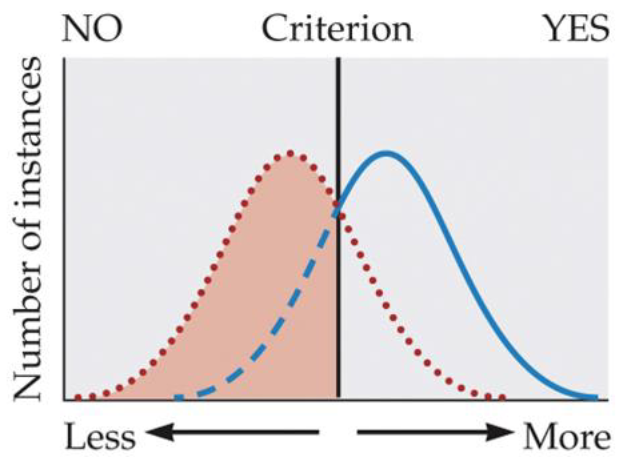
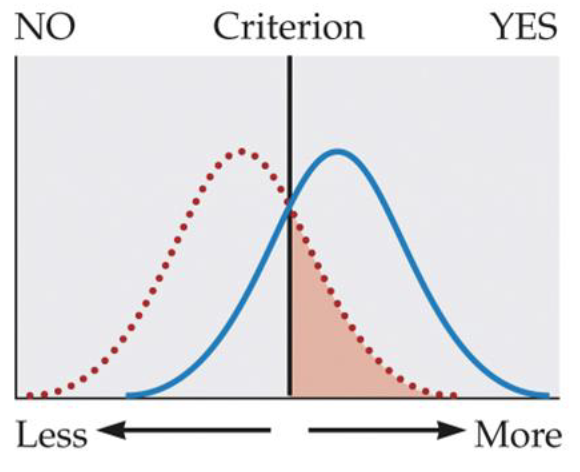
In the graph below, what type of response does the indicated area represent?
False Alarm
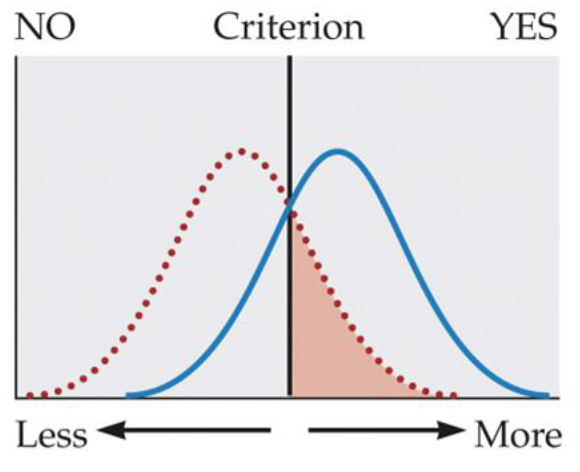
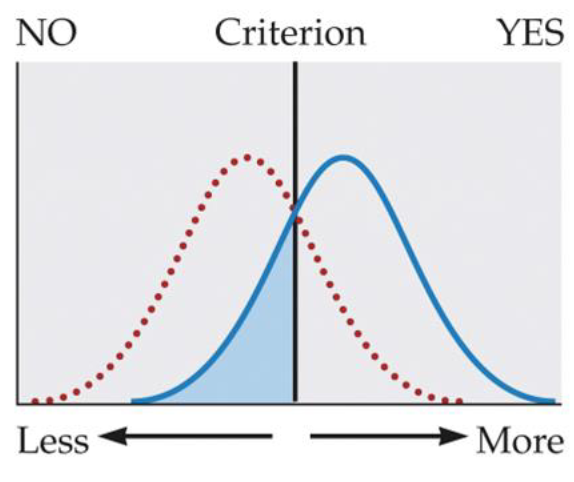
In the graph below, what type of response does the indicated area represent?
Miss
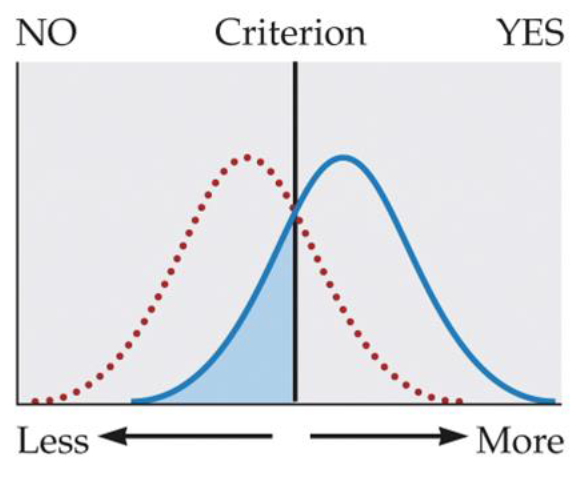
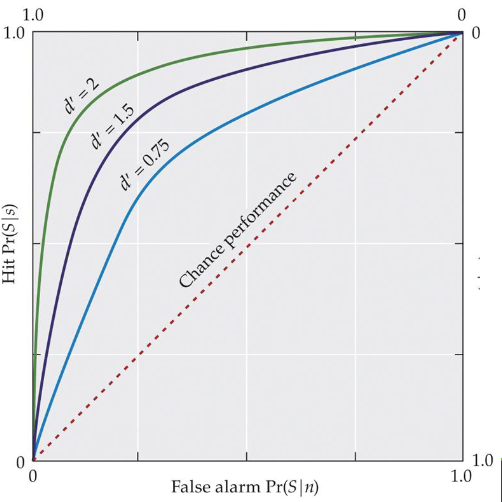
In the graph, which line represents the highest sensitivity?
Green
Sensitivity is the highest in the top left corner of an ROC curve graph.
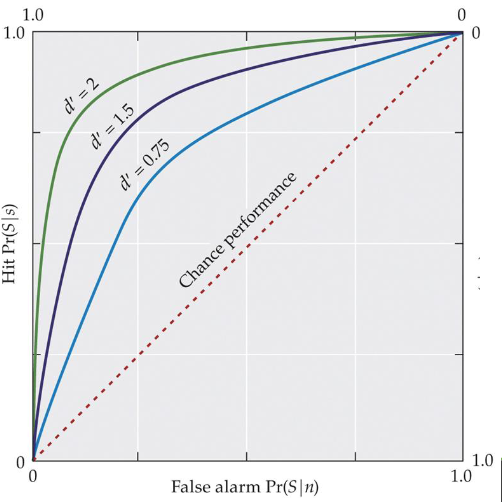
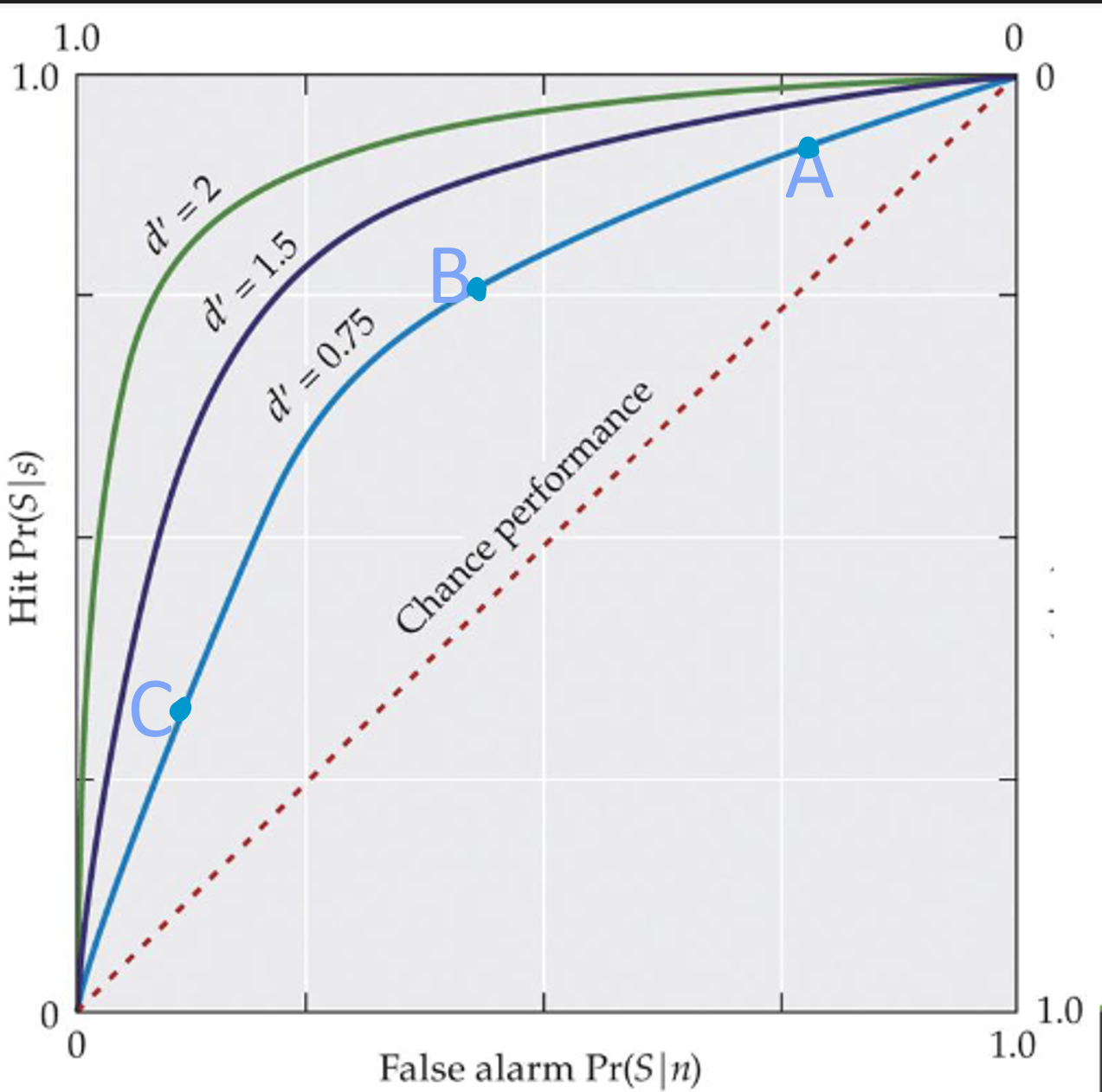
Focusing on the points on the blue line of the graph, which point represents the most liberal criterion?
Point closest to top right corner
A
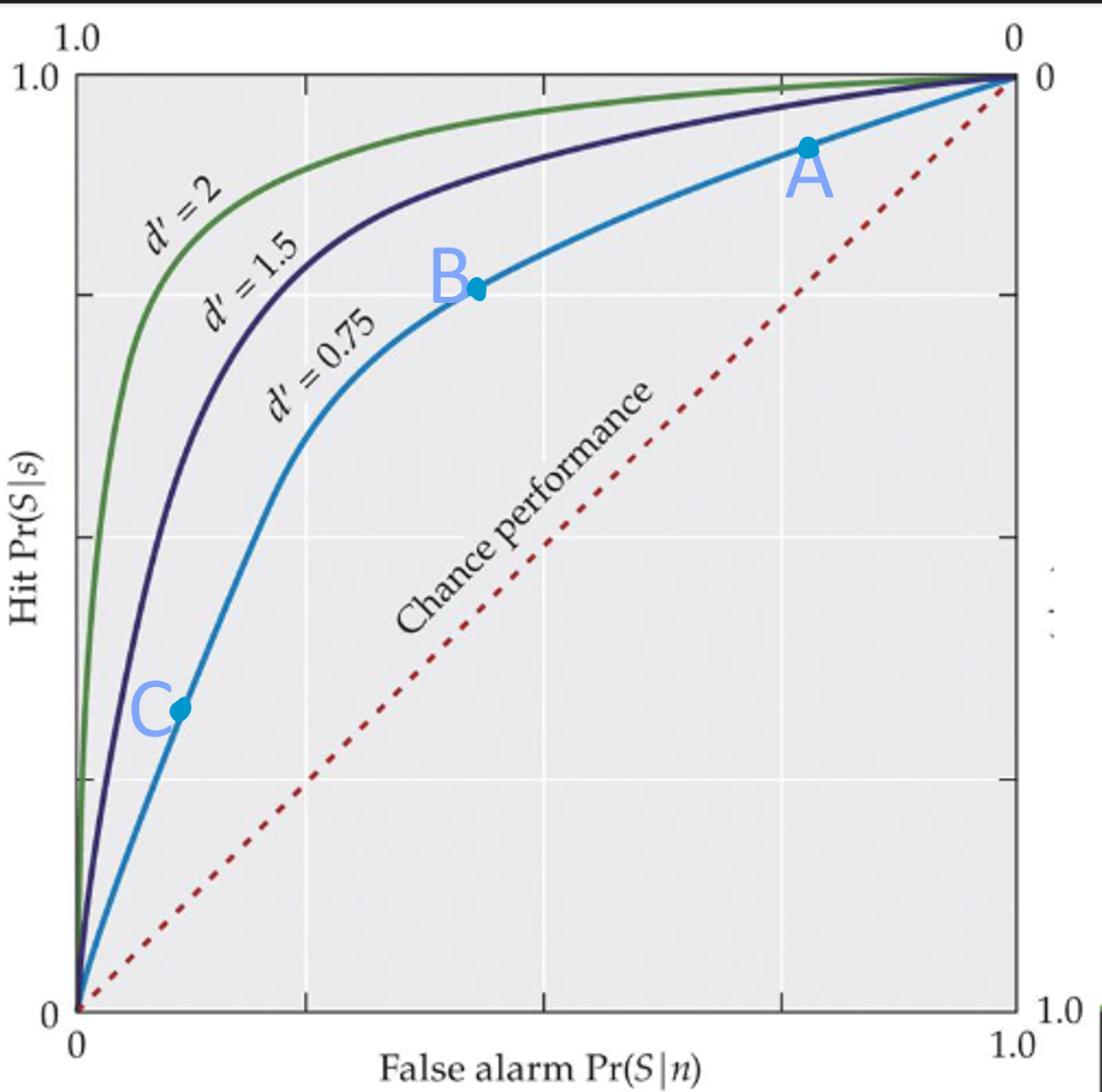
If a stimulus is absent and the observer reports it as absent, this is called a
Correct Rejection
The criminal justice system in United States is designed to be biased such that it would rather let a guilty person go free than convict an innocent person. In terms of signal detection theory, the courts would rather have a _______ than a _______.
Miss than a false alarm
Airport security is very tight. If a traveler even jokes about a bomb, they are detained and questioned to ensure that no real terrorist threat succeeds. In terms of signal detection theory, airport security is prioritizing _______, even if it results in this kind of error: _________.
A hit
False alarm
How many cranial nerves are there?
12
The thalamus is deep in the brain, and not on the brain’s surface. Which technique would be a bad choice to look at the structure of the thalamus?
EEG
MEG
_______ makes it possible to measure localized patterns of activity in the brain by tracking changing levels of blood oxygenation.
fMRI
A cranial nerve that sends information TO the brain from the body, is called _________ and is generally considered ________. [note: I am not asking about Cranial nerve #’s but types of cranial nerves]
Afferent, sensory
Byron is testing salty and sweet taste perception. He gives participants different cups of liquid and asks them to rate how salty and how sweet each liquid is. What two methods does this combine?
Magnitude estimation and method of constant stimuli
When thinking about the physics of light, which of the following are true statements?
Light is spectrum of EM radiation that we can see
Our visible portion is tiny
It is a stream of photons
Has both particle and wave like properties
It can be transmitted (straight through), reflected (redirected back), refracted (bent as it passes through), and scattered (dispersed).
When you look at an opaque, solid red surface, what is happening to the light that hits it?
All wavelengths except the red are being absorbed, where the red is being reflected. Opaque objects prevent all light from passing through
Based on the physics of light, what is one contributing factor to why the sky appears red when the sun is low (sunset) vs. when the sun is high (noon)?
Wavelength and absorption
At sun set more of the suns light is passing through more of the atmosphere to reach you. Even more of the blue light is scattered, allowing the reds and yellows to pass straight through to your eyes.
The transparent “window” on the outer part of the eye that allows light into the eyeball is called the _________________.
Cornea
What portion of the eye makes up 80% of its size?
Vitreous chamber/humor
Which part of the eye undergoes accommodation?
Lens
When considering the fovea, macula, and periphery, what is the pattern of sensitivity to light in low-light situations (from most sensitive to least sensitive)?
Periphery, macula, fovea
Which cells actually sense light?
Photoreceptors (Rods and Cones)
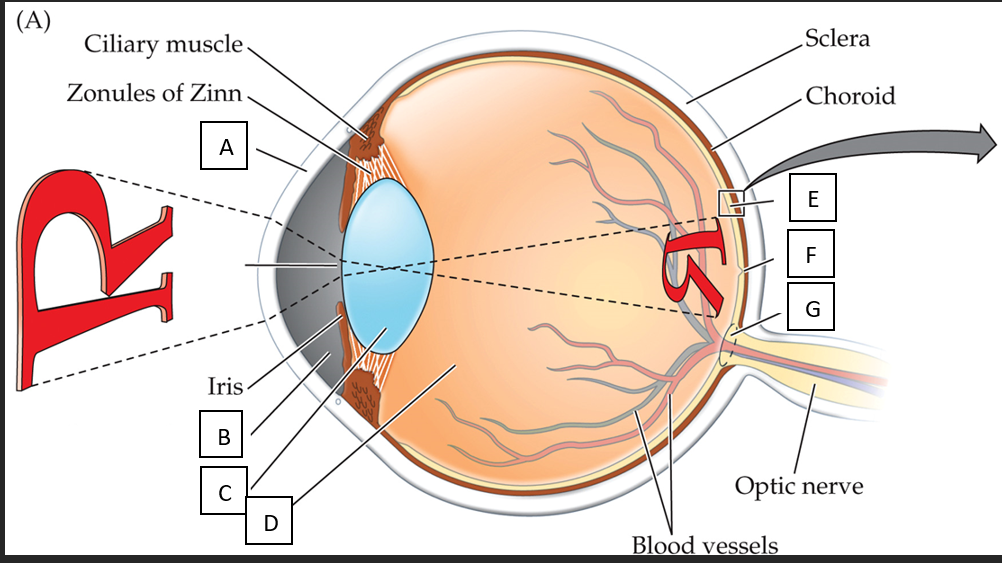
Label the parts of the eye (A-G)
A) Cornea
B) Aqueous Humor
C) Lens
D) Vitreous Humor
E) Retina
F) Fovea
G) Optic Disc
Empty line: pupil
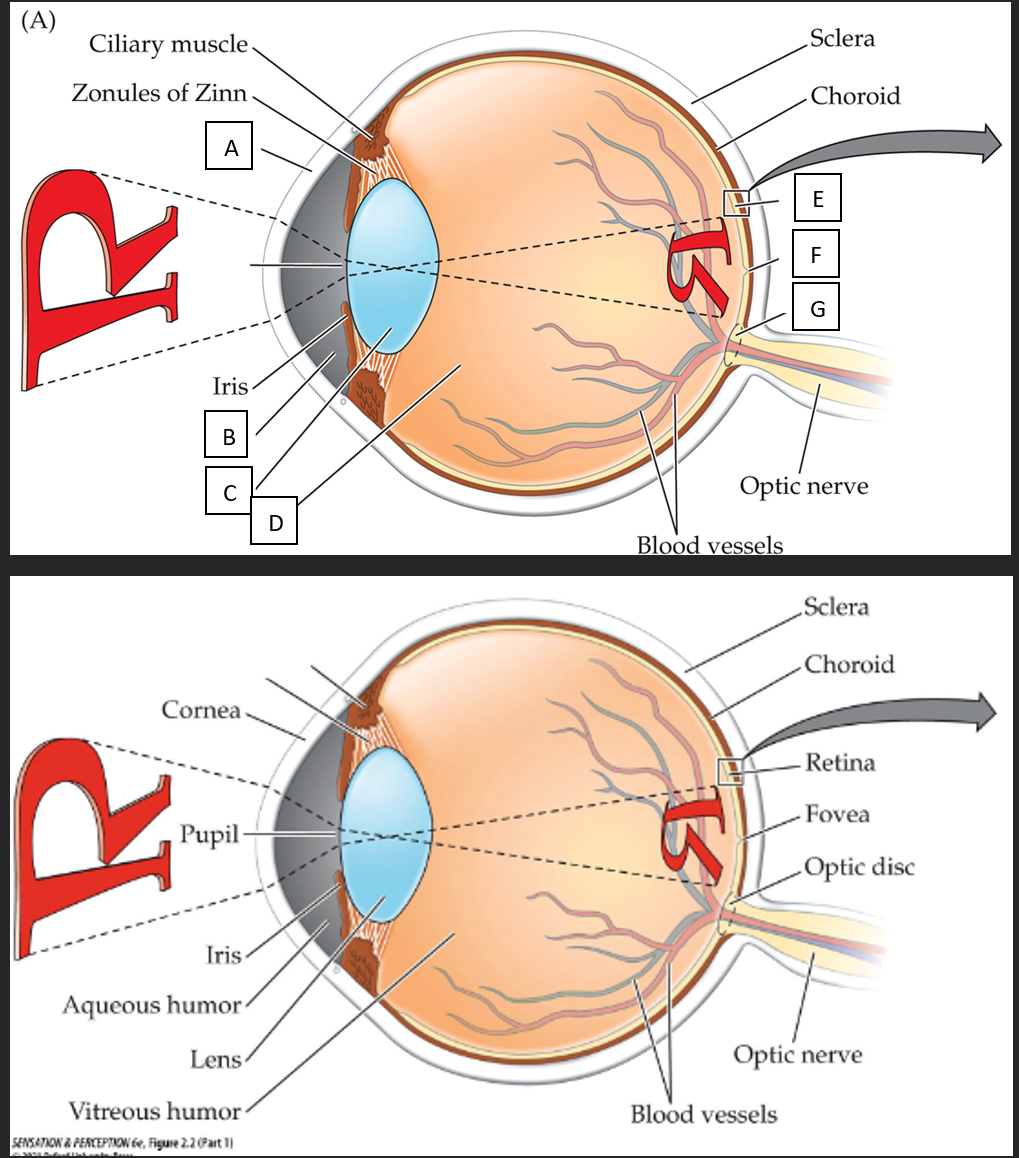
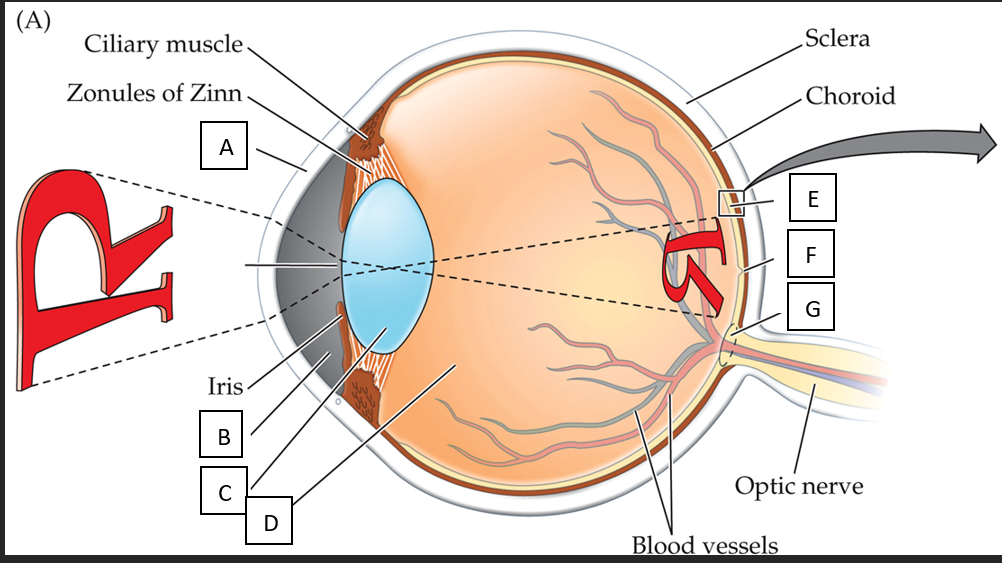
Label the parts of the eye (A-G) with their function
A) The transparent “window” to the eye; first part of eye light hits; has no blood vessels
B) Fluid between the cornea and the lens. Provides oxygen/nutrients to cornea & lens
C) a curved structure that bends/focuses light onto the back of the eye. Crystalline but also flexible
D) the large open space of the eye is the chamber, filled with fluid (humor). 80% of the eye. Gel like fluid that helps maintain eye shape
E) Light sensitive membrane at the back of the eye where photoreceptors are, which transduce light to electrochemical signals
F) Area of retina with highly concentrated amount of photoreceptors (more to come)
G) The point on the eye where the optic nerve exits the eye. As we’ll discuss, it’s called “the blind spot” as it has no photoreceptors
Unlabeled Line: the hole in the musculature that lets light through into the eye

What contributes to high acuity in the fovea?
High concentration of photoreceptors
High number of cones
Divot
Less convergence
People with _______ do not require an optical correction to see normally.
Emmetropia (good eyesight with correct light refraction), 20/20 vision
Mechanisms for dark/light adaptation
Pupil dilation
Pupil’s size changes
Photoreceptors and their replacement
photopigments in a given moment are finite and replenish over time. Too much light results in them becoming bleached
Duplex Retina – Rods/Cones
rods and cones have different rates of photopigment bleaching/replenishment and different light sensitivity
Neural Circuitry beyond Rods/Cones
things like convergence allow the periphery to sense small amounts of light in the dark for example
Suppose your pupils are dilated after visiting the eye doctor. What is the likely effect on the amount of photopigment in your photoreceptors, and why?
The amount of photopigment decreases due to increased photobleaching (increased amount of light striking the retina)
In aging-related macular degeneration (AMD) there is a _______ loss of _______ vision.
Gradual loss of sharp central vision.
The part of the photoreceptor that stores photopigment molecules is called the
Outer Segment
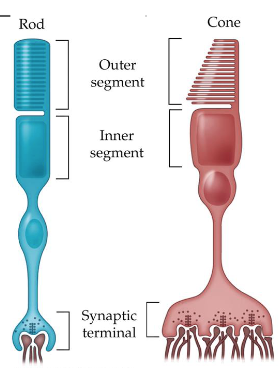
When light strikes a photoreceptor, what happens to its electrochemical process?
When photons (light) hit a photoreceptor, photoactivation begins
Literally means activated by light
Work via graded potentials
The more depolarized the cell is, the more neurotransmitter it releases
When more hyperpolarized, photoreceptors release less glutamate to bipolar cells
When more depolarized, photoreceptors release more glutamate to bipolar cells
Light hyperpolarizes the photoreceptor
Photoreceptors release glutamate, a neurotransmitter
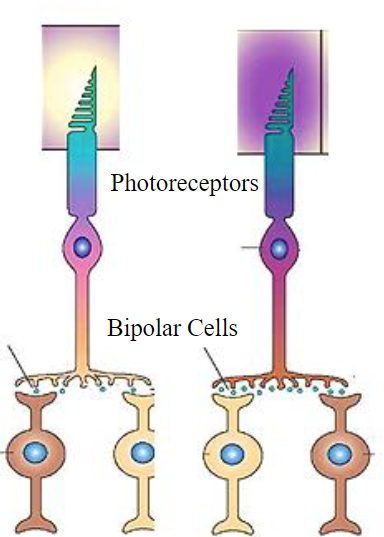
What is lateral inhibition?
adjacent cells at the same level blocking, or inhibiting, each other’s effects
Why is lateral inhibition important for retinal ganglion cell receptive fields?
Literally creates the center surround receptive fields
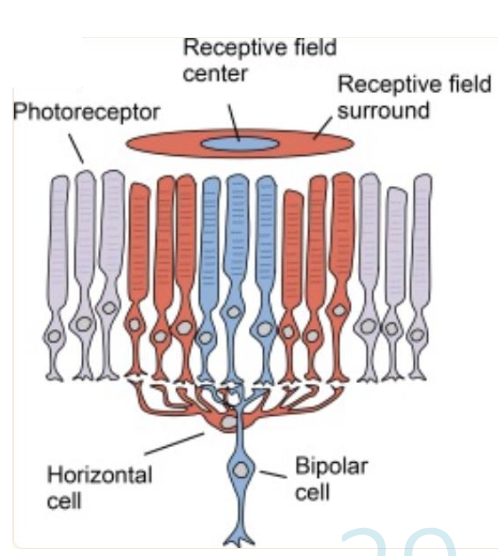
Which of the following are retinal cells that synapse with photoreceptors, horizontal cells, and ganglion cells?
Bipolar Cells
In the fovea, single cones pass information to single ganglion cells via _______ cells
Midget Bipolar Cells
The vertical pathway in the retina consists of
Photoreceptors (Rods and cones) → Bipolar Cells → Ganglion Cells
P ganglion cells are different than M ganglion cells in that P ganglion cells…
By the region of the brain they send their signal
Send information to the parvocellular layer of the lateral geniculate nucleus (LGN) of the brain
By their size
smaller
By type of bipolar cell providing input
Specifically receive input from Midget Bipolar cells (1:1)
Make up 70% of all ganglion cells
Which stimulus would optimally activate an OFF-center ganglion cell?
Ring of light outside the center
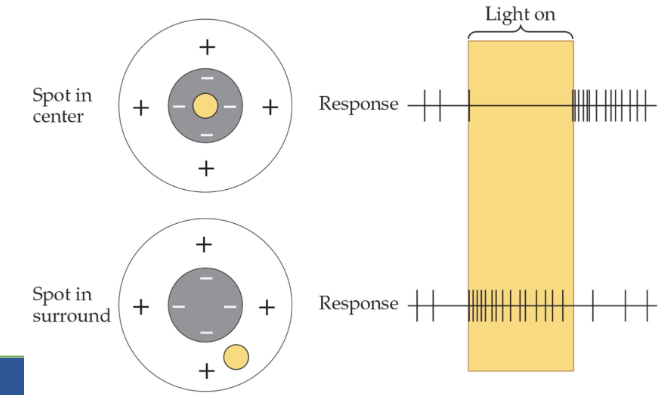
An ON bipolar cell in the fovea becomes more depolarized. What else can you conclude has happened to its photoreceptor?
When light hits photoreceptors depolarizes the bipolar cell, therefore less glutamate released
Light has hit the center of the cell depolarizing it and making it more likely to have an action potential.
More active in light, less glutamate, more activity, more depolarized. Release from inhibition.
Relative to photoreceptors, OFF bipolar cells have a _________ pattern of depolarization because they have __________ glutamate receptors.
Same (Mirror)
excitatory
What is at least one reason we perceive an image as solid gray when the spatial frequencies between black and white bars becomes too high?
Cannot distinguish lines, not resolvable, too small of grating, very poor contrast.
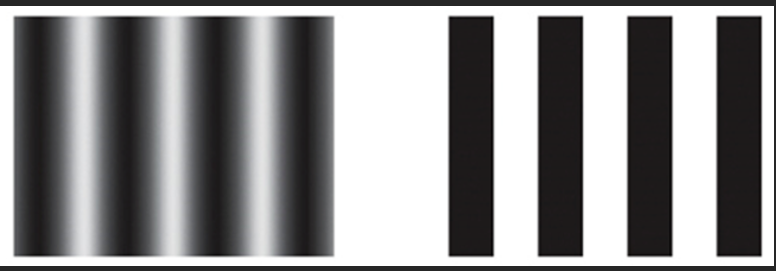
What is the difference between these two patterns?
Different Contrast
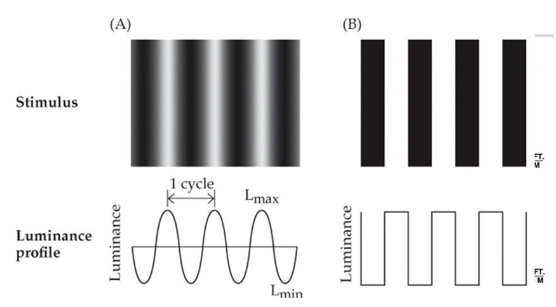
Our Contrast Sensitivity Function is best during what type of vision?
High luminance, low temporal frequency, younger age : higher CSF
Visual angle is a measure of the
Basically calculating the size of an image on the retina based on the angle (size v distance)

The Snellen Eye Test can be considered a test of what threshold of acuity?
Minimum recognizable, Visual Angle Threshold
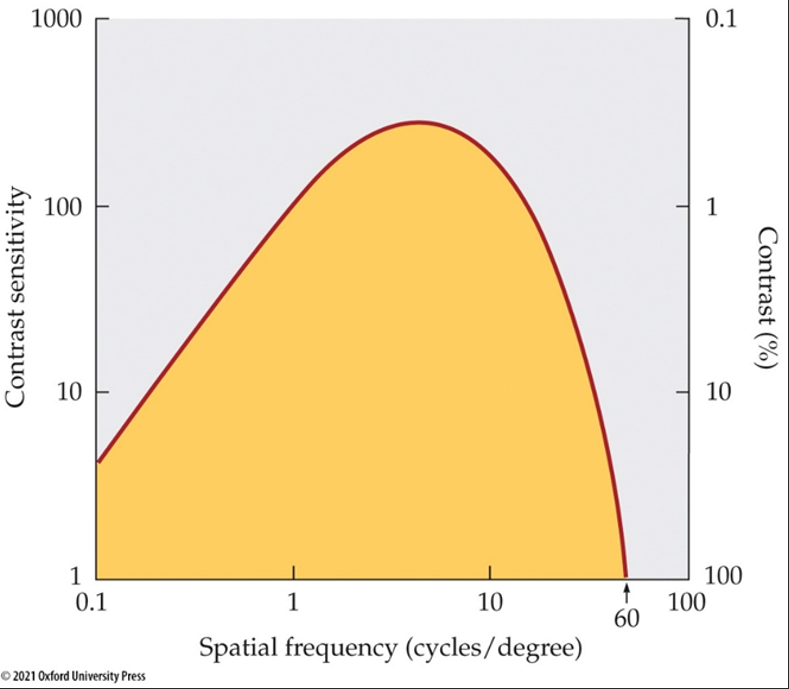
What does the yellow region in the graph refer to?
Visible Region
Contrast Sensitivity Function
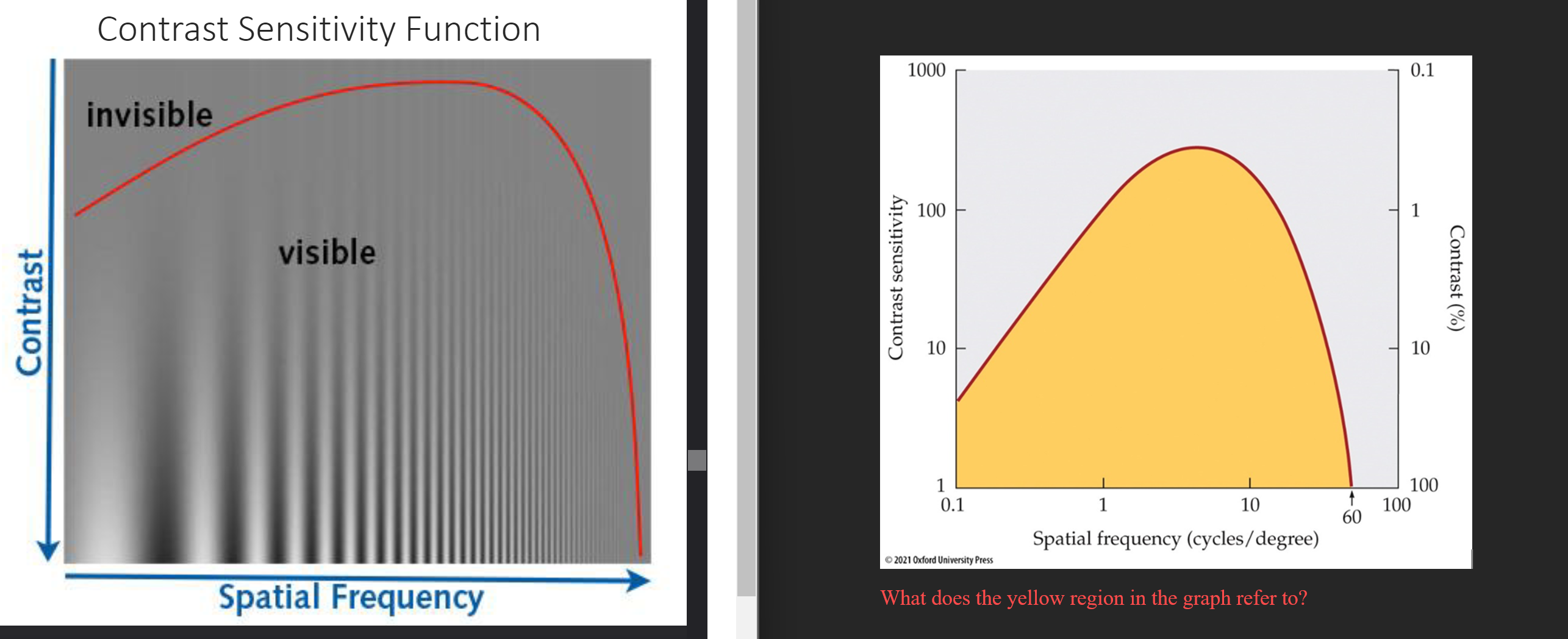
The distance required for one full cycle of a repeating waveform is its
One wavelength
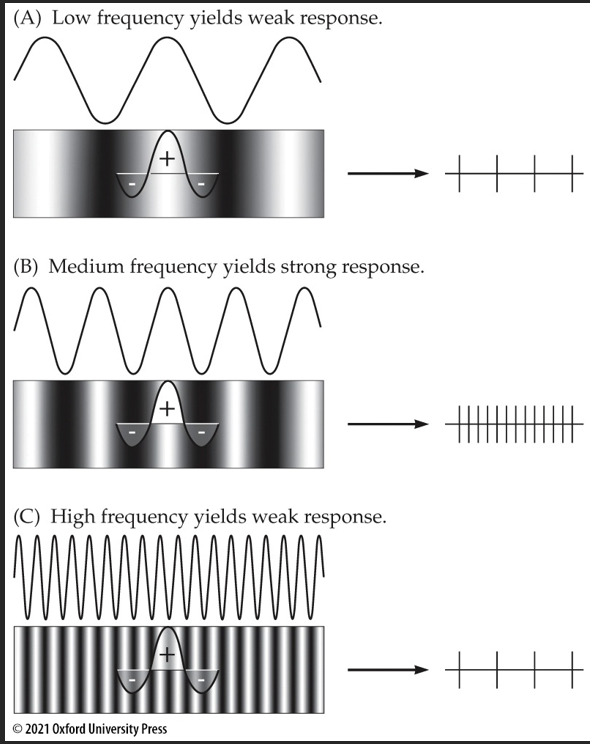
Refer to the figure showing the responses (right) of an ON-center retinal ganglion cell to gratings of different spatial frequencies (left).
The retinal ganglion cell depicted is most responsive to which spatial frequency?
Medium
The parvocellular layer of LGN is _______ and _______ compared to the magnocellular layer:
small receptive fields, high acuity, more cells (more layers)
The right visual field projects to the _______ half of each eye and then is processed by the LGN in the _______ hemisphere.
Right
Left
What layer(s) of LGN process information from the left visual field that hits the fovea of the right eye?
2, 3, 5
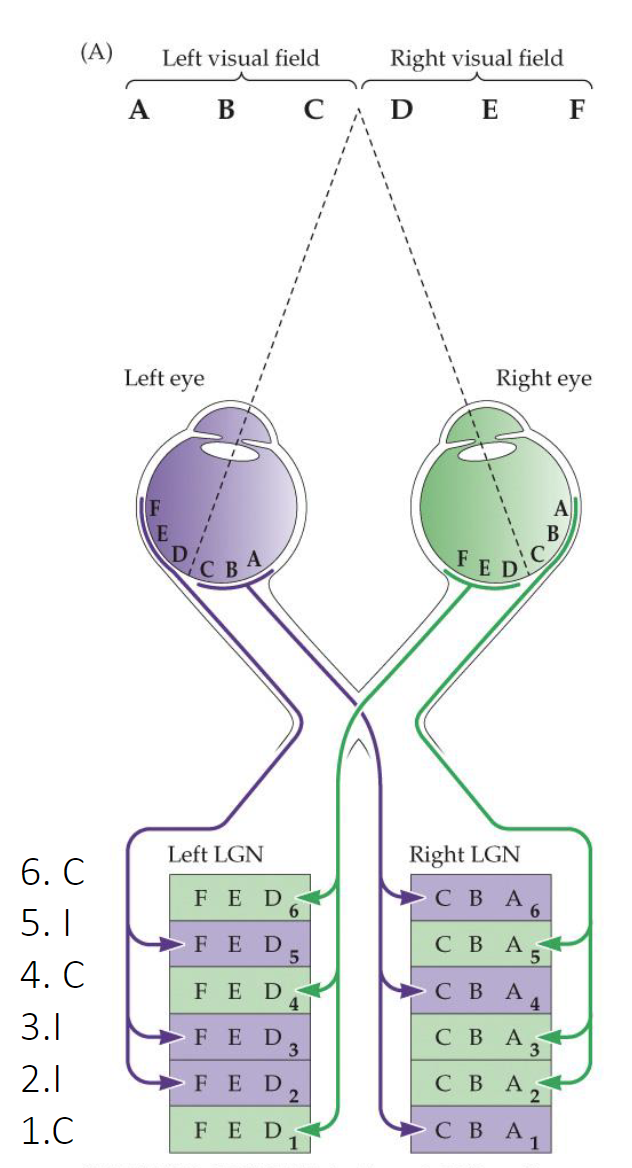
If two objects appear near each other in the world, but are processed by different eyes, how will they be represented in LGN?
They will be represented in different layers (one in 1,4,6 the other in 2,3,5). Retinotopic map still. Next to each other in different layers.
An image from the left side of your visual field that falls on your fovea will be represented where in V1?
Scaled up, upside down, and slightly to the right in the back.
Which object would have the most neurons responding to it in striate cortex, and why?
an object in the fovea, because the fovea has greater cortical magnification than the periphery
Orientation straight up and down, more recorded firings
Visual Crowding
where stimuli are harder to perceive because there are other stimuli around than compared to when they are in isolation
Example: while focusing on the red dot: seeing the key of the left is a lot easier than the one on the right
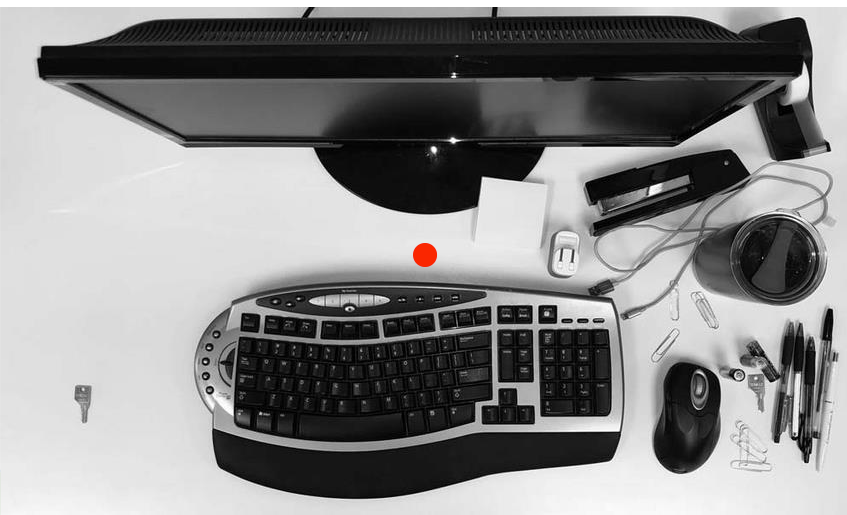
What best describes what is represented within every 0.5 mm square of V1 columns?
Contains all orientations for a given ocular dominance column (Orientation columns organized within ocular dominance columns)
AKA: All possible angles for one eye.
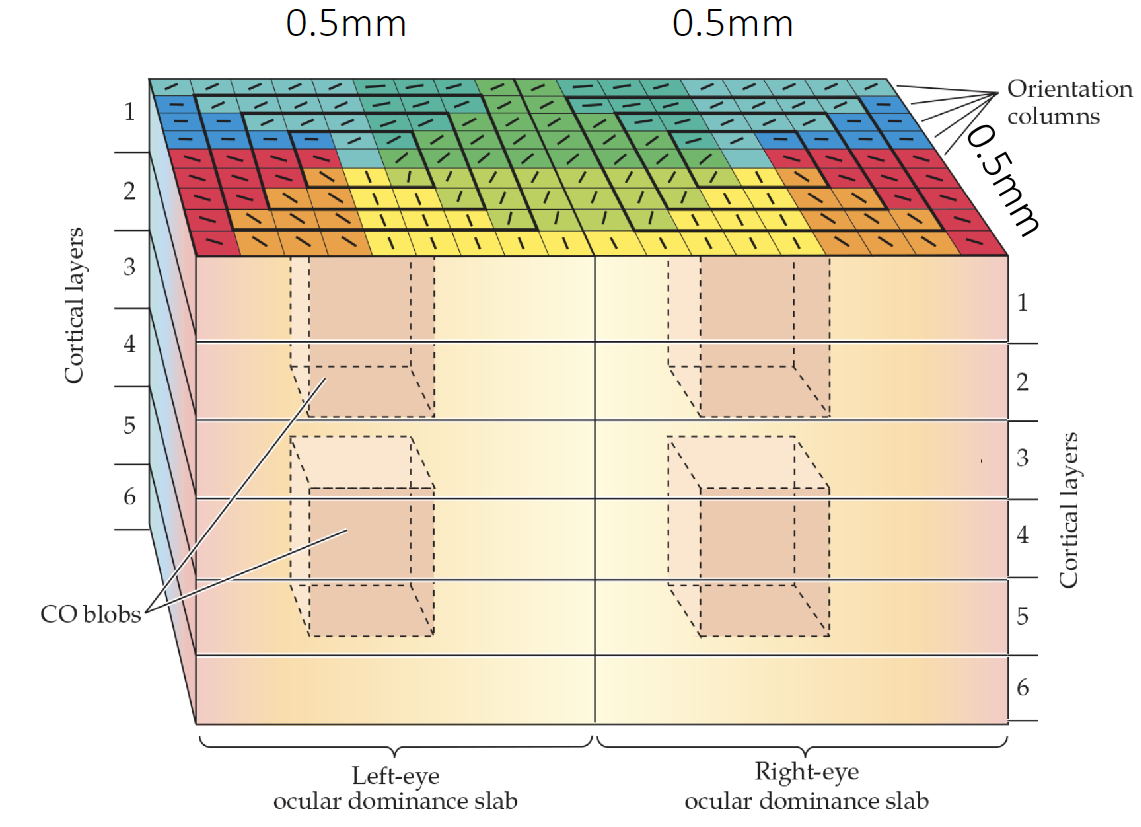
What factors for a bar of light alter V1 simple cells firing rates
DO effect: Orientation, position, length, duration
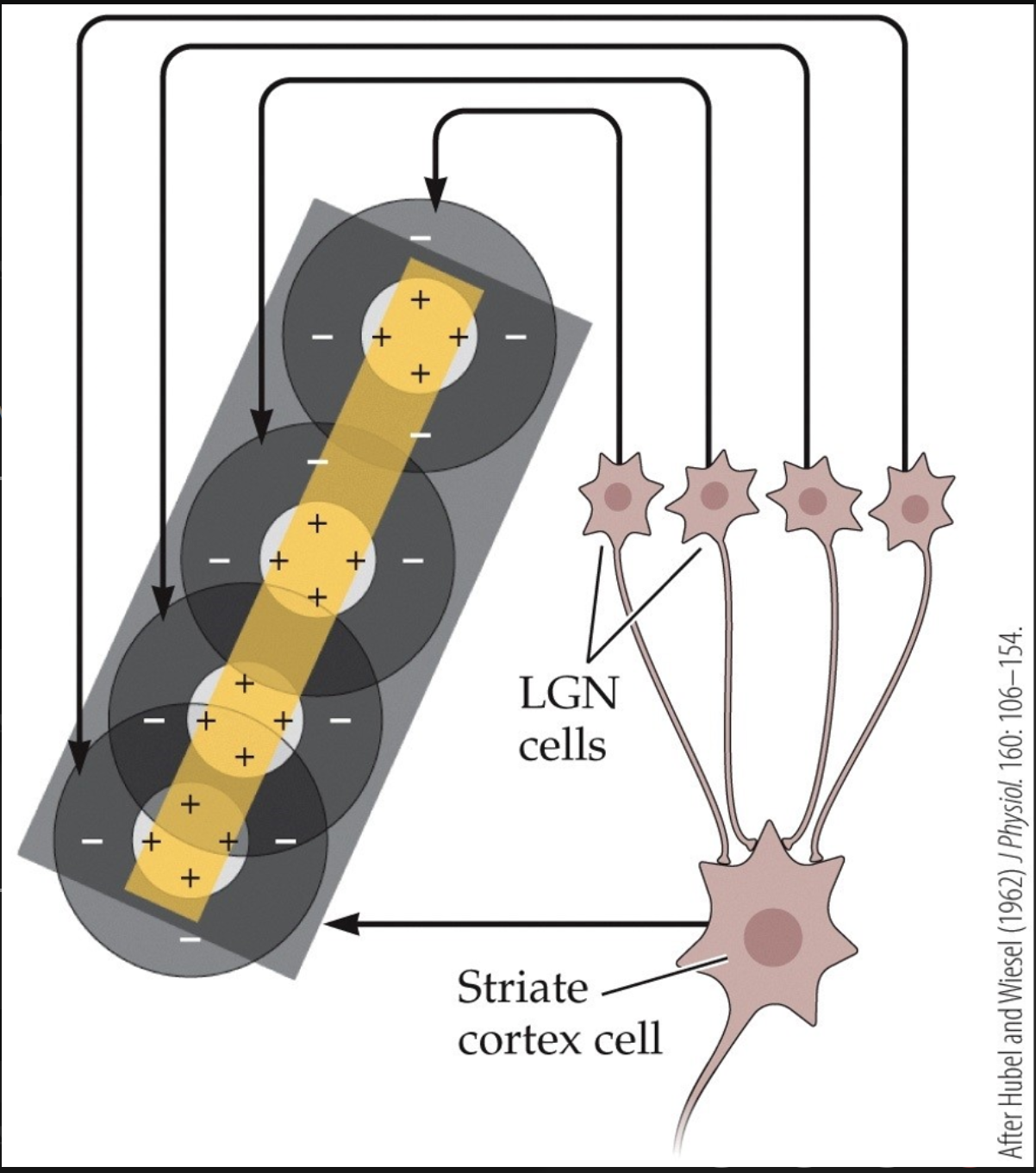
This figure shows:
LGN into V1 (Striate) cells receptive fields
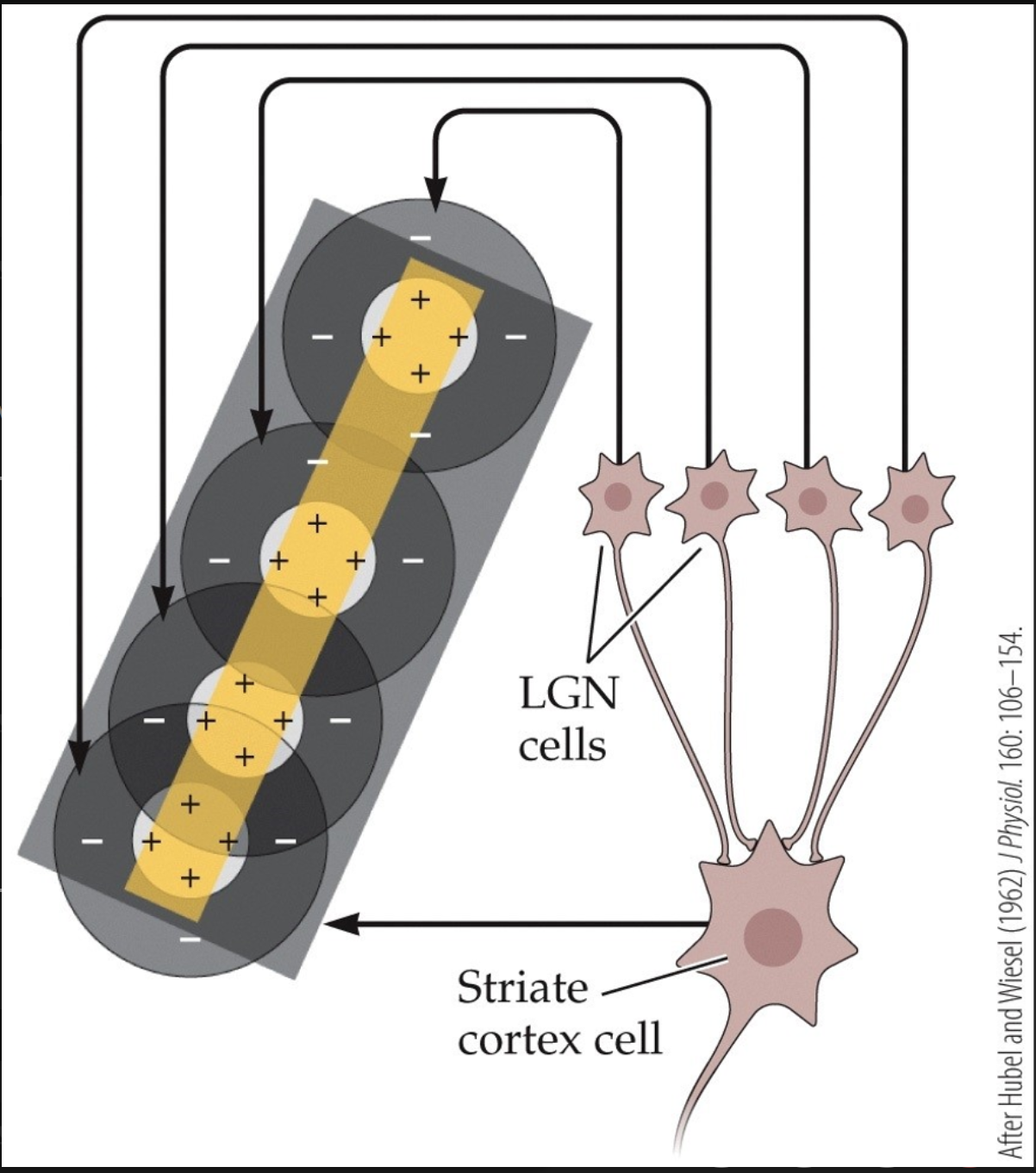
A _______ cell is a V1 neuron whose receptive field does not have clearly defined excitatory and inhibitory regions.
Complex

What phenomenon does the figure BEST demonstrate?
End stopping

Which aspect of a visual stimulus do neurons in CO blobs process?
Color vision (cytochrome oxidase)
The diminishing response of a sense organ to a sustained stimulus is referred to as
Adaptation
What is the FIRST part of the visual system where a single cell can process information from both eyes?
V1
Selective adaption studies of orientations and frequencies demonstrated:
Separable adaptation effects for orientations and spatial frequencies at V1 level

With regards to column size, ocular dominance columns are generally _______ relative to orientation selective columns.
The same size. 0.5 mm
If you record from cells in a particular orientation selective column, what can you say for sure if you were to record from an adjacent orientation selective column in any direction?
Orientation columns always adjacent to similar but slightly different orientation column
Areas of the extrastriate cortex
Still occipital lobe of the brain
V2
V3
V4
Others
Basically if it has a V and a # that isn’t 1, it’s probably extrastriate
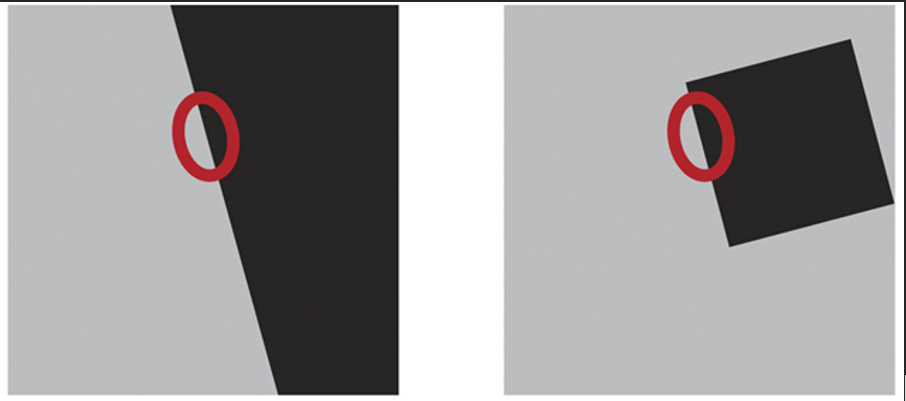
How would V1 vs V2 cells with the red oval receptive field respond to these images?
V1 struggles with these different situations – all look the same to V1
Orientation and edge
V2 receptive fields categorize boundary ownership
In short, codes which part of a visual image is object and which is background
Also understands transparency
Boundary ownership
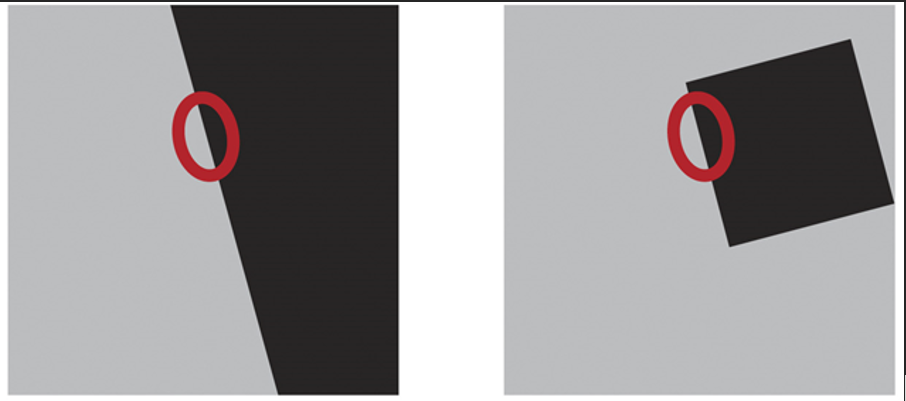
What is one caveat for why grandmother cells are still consider hypothetical:
Very specific, no concrete evidence
Cannot sample all possible faces, so such cells may simply prefer that stimulus compared to the sample
Also no evidence that the particular cell maintains that preference indefinitely
Other highly selective cells show recoding over time
Memory driven rather than just perception
What is the main effect seen in agnosia?
failure to recognize an object even though you are able to see it
Can come in different forms, but all involve a breakdown in object recognition

A _______ process is one that carries out a computation (e.g., object recognition) one neural step after another, without the need for feedback from a later stage to an earlier stage.
Feed-forward
Which theory suggests that you initially get a general, categorical impression of the world from higher brain areas and then later appreciate details after activation flows back down to lower brain areas?
Reverse hierarchy theory
The processing that happens between V2 and V4 is generally considered what kind of vision?
Mid-Level vision
Mid-level vision
1. Bring together that which should be together
2. Split asunder that which should be separate
3. Use what you know (assumes physics and regularity)
4. Avoid accidents (assumes viewpoints aren’t accidental)
5. Seek consensus to avoid ambiguity (“picks” a perception)
Which of the following research topics would be of most interest to a Gestalt psychologist?
The sum is greater than its parts
Closure
Similarity
Proximity
Continuation
Gestalt grouping principles
Closure: Assumption that shapes/objects are complete despite being obscured by other information
Proximity: Assumption that information that is relatively close together must also group together
Continuity: Assumption that lines/edges/contours keep going in their general direction even when encountering other objects
Similarity: Assumption that information that is of the same kind (shape, color, etc.) groups together
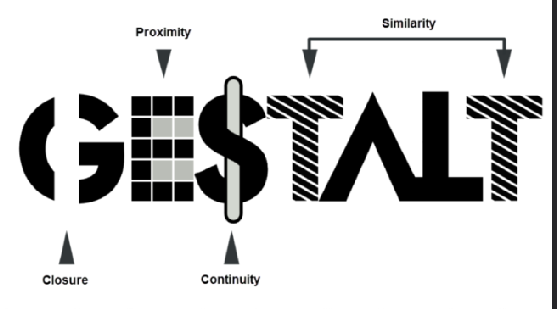
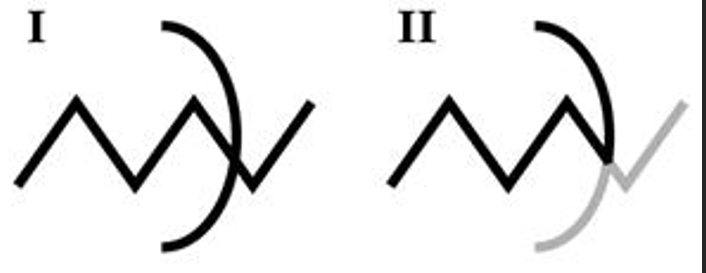
You probably organized figure I into one jagged line and one curved line. Which Gestalt grouping principle guided this decision?
I: Continuity
II: Similarity
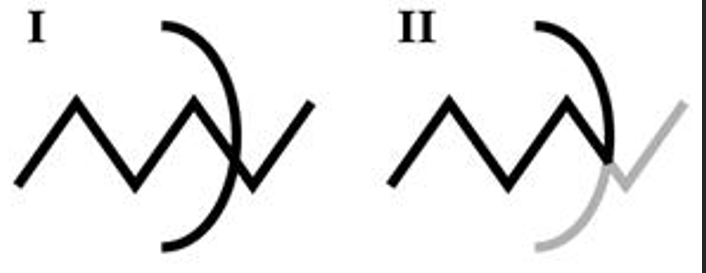
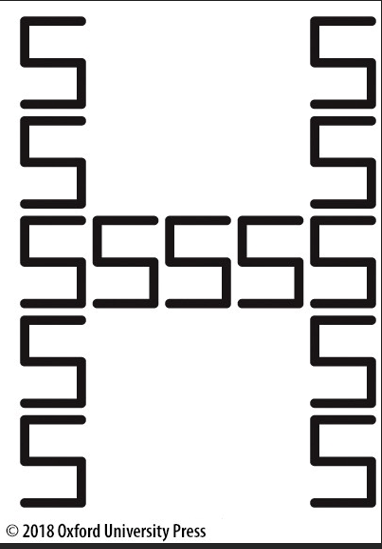
In figures like this one, the big letter (H) interfered with the naming of the small letters (S) more than the small letters interfered with the big. This finding best demonstrates:
Global Superiority (Grouping effect)
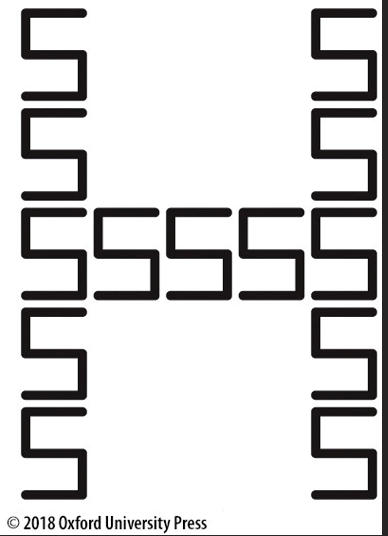
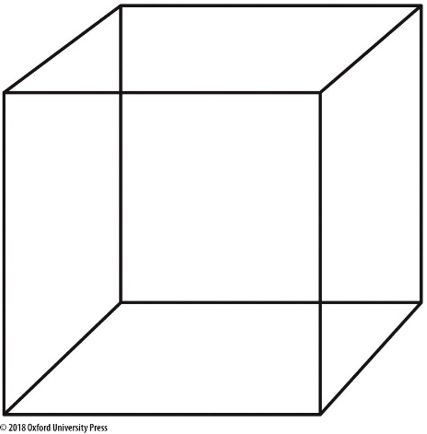
This figure is a classic demonstration of:
Avoiding ambiguity
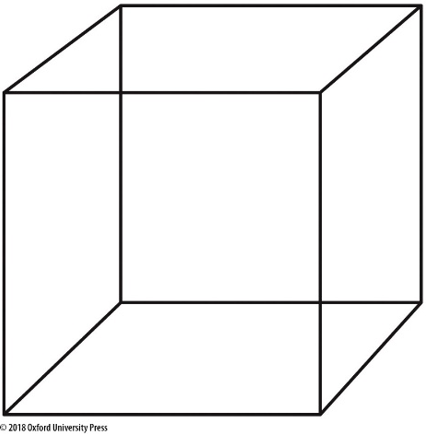
A photo that appears to show a person “holding” the sun from a given angle shows what concept?
Accidental viewpoint
What is a key benefit of having a separate WHAT pathway?
sometimes you need to recognize an object regardless of where you are seeing it
Faster
If an animal has a pattern on its body that provides camouflage and allows it to blend seamlessly into the background, it is trying to prevent _______ by predators that would reveal its location.
Texture segmentation: the visual system’s process of carving an image into regions of common texture properties
relatability
Assuming two line segments that share the same slope/contour are part of a continuous whole
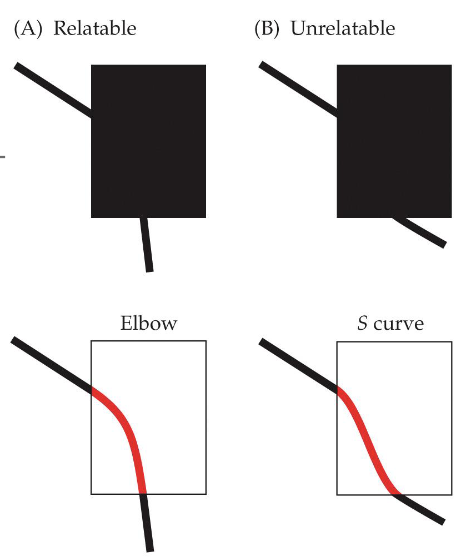
What is one piece of evidence that supports the concept of template models over geon-based models?
Viewpoint matters, inferotemporal cortex
hard to imagine how ALL unique objects could be categorized this way
What are object representations made of, according to the recognition-by-components model of object recognition?
Geons, components, shapes.
